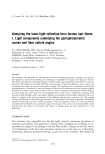276 JOURNAL OF COSMETIC SCIENCE followed by the removal of the structure, leading to a decrease in cuticle thickness or even to the total breakdown of the cuticle. ATOMIC FORCE MICROSCOPY (AFM) This section discusses the results of the use of AFM to investigate the morphology of hair fibers exposed to UV radiation. We were also interested in exploring the changes in the physical nature of the cuticular sheath, which displayed thinning and fusion of the surface cuticle cell, forming bubbles during long-term UV exposure. The AFM technique is a better tool to evaluate thickness, roughness, and scale lifting because of several advantages over SEM, among which are its higher resolution, which can reach the molecular or even atomic scale, and the generation of digital images from three-dimensional topographic data, which can be quantitatively analyzed in 3D. Figure 4a presents a photomicrograph of unexposed hair presenting a schematic box cursor used for the AFM measurements. A previous observation allows us to place the box cursors significantly away from the cuticle edges. In this figure, we can observe that the unexposed hair consists of short cuticles oriented longitudinally and aligned in the direction of the fiber in a regular manner, devoid of the presence of fractures or hole-like depressions in low relief. Figure 4b illustrates the effect of UV radiation (160 hours) on the surface morphology of the hair fibers. Although the cuticular structure is still discernible, its appearance indicates considerable change. As can be seen, the UV- exposed hair presents large cuticle scales, which resulted from the breakdown of the other layers. The roughness of these fibers can be estimated based on the images in Figures 4a and 4b. The surface roughness of unexposed and UV-exposed hair was calculated by the average roughness (Ra) for 11 regions, using the Nanoscope © software of the AFM instrument. The average roughness, Ra, is defined as: the arithmetic average of the absolute values of the surface height deviations, measured from the mean plane within the box cursor. The data shown in Table I were treated statically by means of the SAS software, using the GLM procedure, which includes the Student t-test. An increase in roughness from 5.4 to 16.0 was observed from unexposed to UV-exposed hair fibers, and such an increase is statistically significant, with p 0.0001. The symbol p represents the probability that the damaged hair is statically equal to the unexposed hair. One minus p represents the level of confidence that the hair sets are really different. These data confirm the irregular topography shown by the SEM technique for hair exposed to UV radiation for 160 hours. This study showed that AFM is an excellent analytical technique to provide quantitative information on morphological changes in hair exposed to UV radiation. Supported by the Nanoscope © software, we evaluated the thinning of the cuticle through section analysis in two ways: First, as illustrated in Figures 5a and 5b, three cross sections were made for each one of the eleven regions evaluated. The cross sections of the hair fibers give origin to different profiles, for the unexposed and exposed hair. The overall perimeter of a studied profile, representing the length that would be obtained by stretching the fibers, is called surface distance. The cross sections of the hair samples in Figures 5a and 5b show that the profile of unexposed hair presents higher peaks than the profile of exposed hair. The natural consequence of this, taking into account the definition of surface distance, is that
EVALUATION OF UV HAIR DAMAGE BY AFM 277 -20.0 Box Statistics Mean roughness (Ra) 4.278 Box x ai.ension 1.583 Box g aiaension 1.563 -10.0 -o [J 1 o'. o 20'. o i J. :m I I I 0 10.0 20.0 -20.0 -10.0 -0 Figure 4. AFM images of hair. (a) Control: virgin hair (0 hours) showing the schematic position of a box cursor. (b) Exposed (160 hours) to UV radiation. unexposed hair samples present higher values of surface distance. These higher peaks are related to the profile that one might expect from a cross section of the unexposed hair cuticles. On the other hand, the loss of protein from the damaged hair leads to a smaller thickness of the cuticle and a smoother profile and thus to a smaller surface distance. The
Purchased for the exclusive use of nofirst nolast (unknown) From: SCC Media Library & Resource Center (library.scconline.org)


























































































